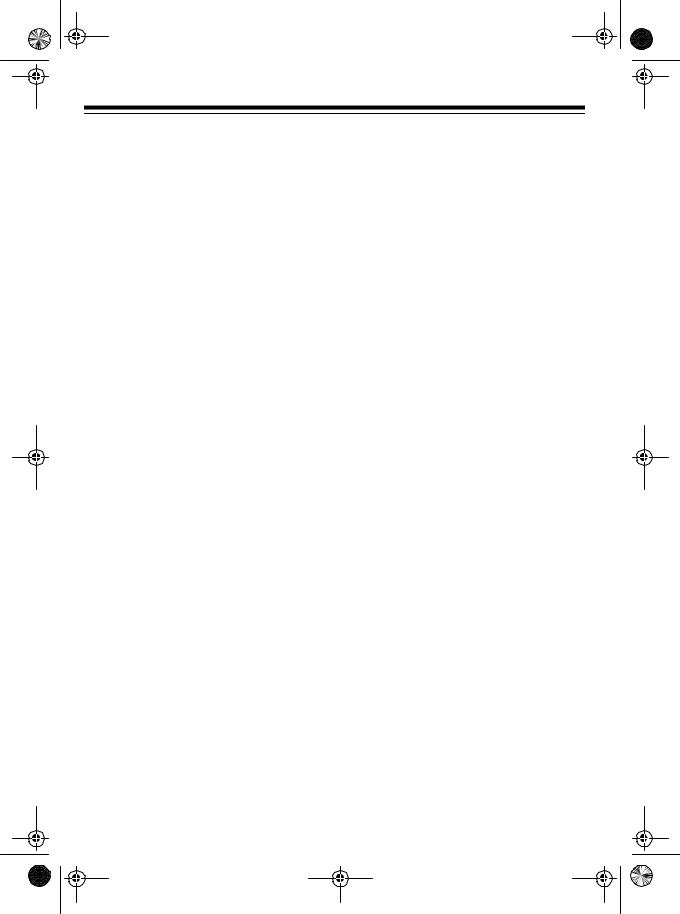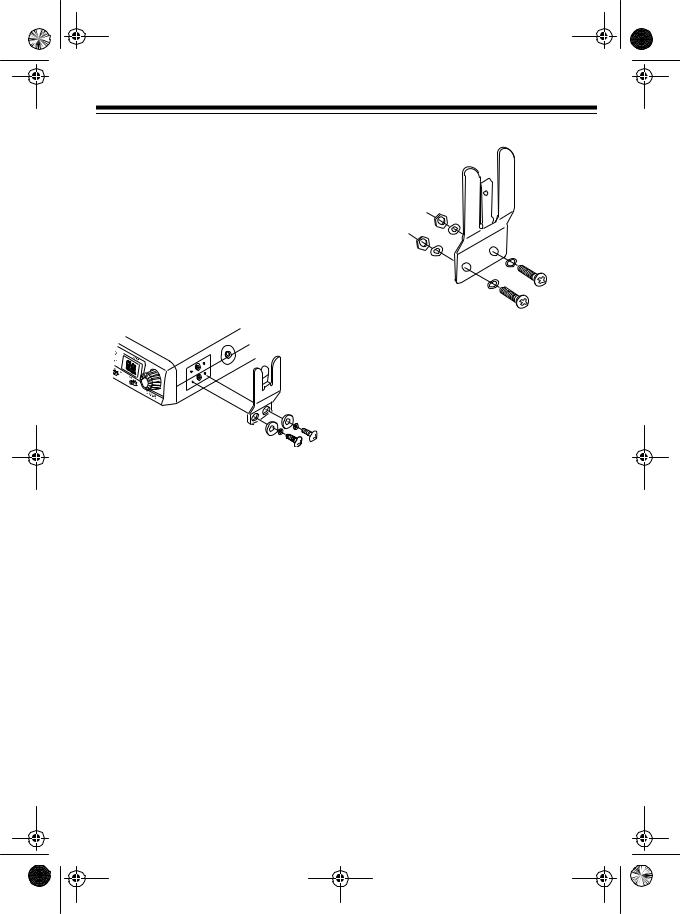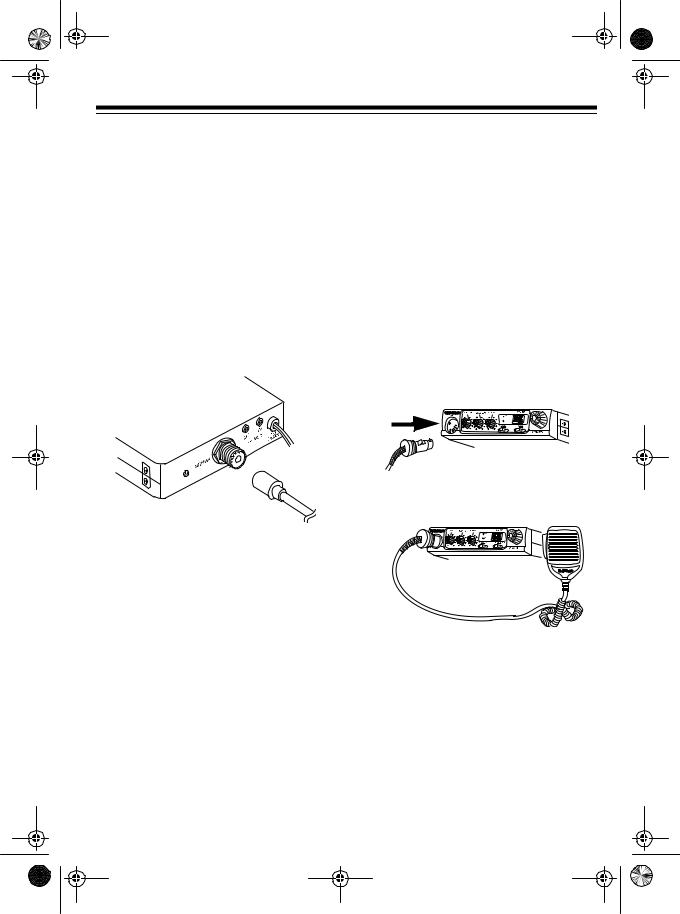RadioShack TRC-504 Owners Manual

21-1704.fm Page 1 Thursday, August 5, 1999 1:20 PM
Cat. No. 21-1704
OWNER’S MANUAL
Please read before using this equipment.
TRC-504
40-Channel Mobile CB Radio
with On-Mic Channel Selector

21-1704.fm Page 2 Thursday, August 5, 1999 1:20 PM
FEATURES
Your RadioShack TRC-504 Compact 40-Channel Mobile CB Radio is a breakthrough in CB design technology. You can mount it in a vehicle for mobile use, or in your home for use as a base station.
Your CB has these advanced features:
Dual Channel Controls — let you tune the channel from the transceiver or the handset.
RF Gain Control — lets you adjust the receiver’s gain to match the strength of the signal.
Emergency Channel Switch — lets you quickly switch to Channel 9 or 19 so you can monitor or report emergency situations.
Two-Digit Channel Display with TX (Transmit) and RX (Receive) Indicators — lets you see the CB’s operating status at a glance.
External Speaker Jack — lets you connect your CB to an external speaker.
Built-In PA (Public Address) Amplifier
— lets you use your CB as a public address system when you add an optional PA speaker.
Backlit Controls — help you easily find the right control when you use the CB at night.
Phase-Locked Loop (PLL) Frequency Synthesizer — provides highly accurate and stable tuning.
Two Built-In Ceramic Filters — ensure superior channel selectivity and freedom from adjacent channel interference.
Automatic Modulation Control — prevents the transmitter signal from overmodulating and distorting.
Automatic Noise Limiter — reduces impulse-type noises while receiving.
Universal Mounting Bracket — lets you mount your CB securely in your vehicle or on a table or shelf in your home.
Note: To use this CB, you must connect a mobile or base station antenna. Your local RadioShack store has a wide variety of antennas. For more information, see “Connecting an Antenna” on Page 6.
We recommend you record your CB’s serial number here. The number is on the CB’s bottom cabinet.
Serial Number _________________
© 1998 Tandy Corporation.
All Rights Reserved.
RadioShack and Powerhorn are registered trademarks used by Tandy Corporation.
2

21-1704.fm Page 3 Thursday, August 5, 1999 1:20 PM
FCC INFORMATION
The Federal Communications Commission (FCC) does not require you to have a license to operate this CB radio. However, you must know Part 95 of FCC Rules. It explains the proper operation of a Class D citizen’s band transceiver. We enclosed a copy of Part 95 with your CB radio.
Warning: Do not open the CB radio to make any internal adjustments. A CB radio is set up to transmit a regulated signal on an assigned frequency. It is against the law to alter or adjust the settings inside the unit to exceed these limitations.
To be safe and sure:
•Never open your CB radio’s case.
•Never change or replace anything in your CB radio.
Your CB radio might cause TV or radio interference even when it is operating properly. To determine whether your CB radio is causing the interference, turn off your CB radio. If the interference goes away, your CB radio is causing it. Try to eliminate the interference by:
•moving your CB radio away from the receiver
•contacting your local RadioShack store for help
This device complies with Part 95 of FCC Rules. Operation is subject to the following two conditions: (1) this device may not cause harmful interference, and
(2) this device must accept any interference received, including interference that may cause undesired operation.
3

21-1704.fm Page 4 Thursday, August 5, 1999 1:20 PM
CONTENTS |
|
Installation ............................................................................................................... |
5 |
Attaching the Microphone Holder ....................................................................... |
5 |
Mounting the Transceiver ................................................................................... |
5 |
Connecting an Antenna ...................................................................................... |
6 |
Connecting the Microphone ................................................................................ |
7 |
External Speaker ................................................................................................ |
8 |
Connecting a CB Speaker ........................................................................... |
8 |
Connecting a PA Speaker ............................................................................ |
8 |
Using Vehicle Battery Power .............................................................................. |
9 |
Using the Transceiver as a Base Station ............................................................ |
9 |
Operation ............................................................................................................... |
11 |
Receiving Transmissions and Adjusting Squelch ............................................. |
11 |
Transmitting ...................................................................................................... |
12 |
Selecting the Emergency Channel ................................................................... |
12 |
Using the PA Amplifier ...................................................................................... |
12 |
Using the Monitor Feature ................................................................................ |
13 |
Operational Hints .................................................................................................. |
14 |
Common Uses for a CB .................................................................................... |
14 |
Personal Uses ............................................................................................ |
14 |
Business Uses ........................................................................................... |
14 |
Transmission Courtesy ..................................................................................... |
14 |
Using Common 10-Codes ................................................................................ |
15 |
Maximum Range .............................................................................................. |
16 |
Troubleshooting .................................................................................................... |
17 |
Reducing Noise ................................................................................................ |
19 |
Care and Maintenance .......................................................................................... |
20 |
Replacing the Fuse ........................................................................................... |
21 |
Specifications ........................................................................................................ |
22 |
4

21-1704.fm Page 5 Thursday, August 5, 1999 1:20 PM
INSTALLATION
ATTACHING THE
MICROPHONE HOLDER
You can attach the microphone holder to either side of the transceiver or to another location in your vehicle.
To attach the holder to the transceiver, secure the holder to either side using the supplied 3 mm screws and lock washers.
Note: If you cannot reach behind the mounting surface to attach the nuts on the machine screws, use the supplied 3 mm plain washers and self-tapping screws.
To attach the holder to another location in the vehicle, such as the dashboard, follow these steps.
1.Using the holder as a template, mark the positions for the mounting screw holes at the desired location.
2.At each marked position, drill a hole slightly smaller than the supplied mounting screws.
Caution: Be careful not to drill into anything behind the mounting surface.
3.Attach the holder at the mounting location using the supplied machine screws, spring washers, plain washers, and nuts.
MOUNTING THE
TRANSCEIVER
The most common mounting location for this CB is under a vehicle’s dashboard. However, if you plan to use the TRC504 as a base station, you can place it on a desk, shelf, or table (see “Using the Transceiver as a Base Station” on Page 9).
If you are mounting the CB in a vehicle, choose a location where:
•You can easily reach the CB.
•Wires and cables are clear of the vehicle’s pedals or other moving parts.
•The CB is not directly in front of heating vents.
•All wires and cables can reach their connection points.
5

21-1704.fm Page 6 Thursday, August 5, 1999 1:20 PM
Cautions:
•If you use the CB in a vehicle, mount it securely to avoid damage to the CB or vehicle or injury to anyone in the vehicle during sudden starts or stops.
•Do not mount the CB where it could damage or interfere with the operation of any passive restraint safety device (an airbag or seat belt).
Follow these steps to mount the CB using the supplied hardware.
1.Using the mounting bracket as a template, mark the positions for the screw holes on the mounting surface.
2.In each marked location, drill a hole slightly smaller than the supplied mounting screws.
Caution: Be careful not to drill into objects behind the mounting surface.
3.Mount the bracket to the mounting surface with the supplied 5 mm bolts, spring washers, plain washers, and nuts.
Note: If you cannot reach behind the mounting surface to attach the nuts on the bolts, use the supplied 5 mm self-tapping screws and plain washers to secure the bracket.
4.Attach the CB to the mounting bracket using the supplied rubber washers and mounting knobs.
CONNECTING AN
ANTENNA
There are many different types of CB antennas for mobile CBs. Each type has its own benefits, so choose the one that best meets your needs. Your local RadioShack store sells a wide variety of antennas.
Note: If you are using this CB as a base station, see “Using the Transceiver as a Base Station” on Page 9.
6

21-1704.fm Page 7 Thursday, August 5, 1999 1:20 PM
When you choose an antenna, keep in mind that, for the best performance, you should mount the antenna:
•as high as possible on the vehicle
•as far as possible from sources of electrical noise
•vertically
Once you choose an antenna, follow its mounting instructions. Then route the cable to the transceiver and connect the cable to the ANTENNA jack on the back of the transceiver.
Follow the instructions supplied with the SWR meter and antenna to adjust your antenna’s SWR to the lowest possible value. SWR values of 2.0:1 are generally acceptable, with readings of 1.5:1 or lower being more desirable.
CONNECTING THE
MICROPHONE
1.Align the tab on the side of the supplied microphone’s plug with the notch in the microphone jack (on the side of the transceiver). Then insert the plug into the jack.
Cautions:
•Avoid routing the cable next to sharp edges or moving parts, which might damage the cable.
•Do not run the cable next to power cables or other radio antenna cables.
•Do not run the cable through the engine compartment or other areas that produce extreme heat.
To take advantage of your radio’s maximum range, adjust the antenna’s Standing Wave Ratio (SWR) using an SWR meter (not supplied).
2.Slide the microphone onto the microphone holder.
To disconnect the microphone from the transceiver, press the tab on the side of the plug, then pull out the plug.
Caution: Never pull on the microphone cable.
7

21-1704.fm Page 8 Thursday, August 5, 1999 1:20 PM
CONNECTING AN
EXTERNAL SPEAKER
You can connect your transceiver to an external CB speaker, so you can hear an incoming call when you are outside your vehicle, or use the CB as a PA system.
Connecting a CB Speaker
Connecting a PA Speaker
The PA speaker should:
•have an impedance of 8 ohms
•be able to handle at least 5 watts of power (the RadioShack Powerhorn® series speakers meet this requirement)
•have a cable with a 1/8-inch plug
The external speaker you use with the transceiver should have an impedance of 8 ohms and be able to handle 3 to 10 watts of power (such as RadioShack Cat. No. 21-549). The speaker cable must have a 1/8-inch plug.
To connect the external speaker to the transceiver, insert the speaker cable’s plug into EXT SPEAKER on the back of the CB.
To External
Speaker
Note: When you connect an external speaker, the CB’s internal speaker disconnects.
If your PA speaker meets the other specifications but does not already have a 1/8-inch plug, you can connect it using a phono plug-to-wire cable, available at your local RadioShack store.
To connect the PA speaker to the transceiver, insert the speaker cable’s plug into PA SPEAKER on the back of the CB.
To External
PA Speaker
Note: To avoid acoustic feedback, the speaker should be at least 6 feet from the CB. If you experience feedback, avoid keying the microphone until you have moved the speaker away from the CB.
8
